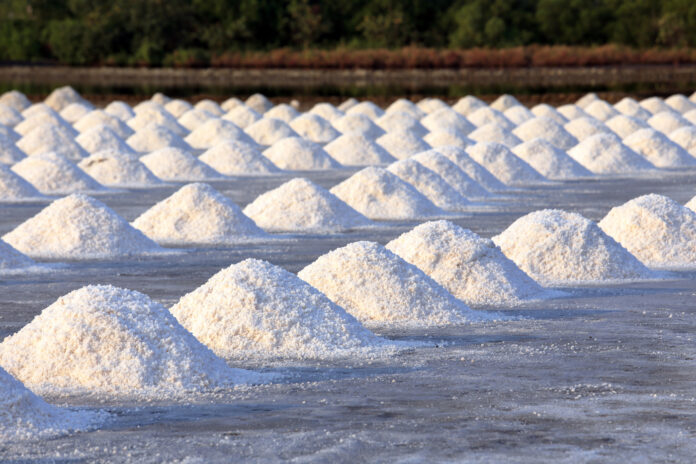The cannabis plant faces a particularly perilous journey from cure to consumption. Throughout all stages of the supply chain, headspace air in the container in which flower is stored can lead to trichome degradation and terpene loss, not to mention lost water weight. Overly humid conditions may also contribute to mold growth, which could prove especially problematic for people using cannabis medicinally.
Salts have been used for thousands of years as a humidity control tool and preservative in a variety of industries. Recently, scientists discovered the abundant mineral also is capable of safely and effectively solving some of the cannabis supply chain’s most critical issues.
When it comes to how cannabis is stored, the relative humidity (RH) of the immediate environment plays a critical role in the product’s lifespan because RH directly affects water activity. Water activity (aw) indicates the rate at which water passes in and out of a substance and is not to be confused with moisture content, which is the amount of water within the substance. Properly controlling aw can extend the shelf life of a product.
When aw values are too low, cannabis may become brittle and lose potency. If the aw becomes too high, mold and other microbes can develop.
Saturated salt solutions can control RH in containers of cannabis with precision. When enclosed in a semipermeable vapor phase osmosis membrane, salt solutions release or absorb water vapor as needed to create and maintain a stable RH throughout the headspace air. The salt within the packet dissolves when more water is absorbed and becomes solid again when water is released, keeping the aw level stable and safeguarding the cannabis.
“Think about it like this: When you mix a powdered beverage, you pour the powder into water and stir or shake until it dissolves and you can no longer see the powder,” said packaging engineer Brian Rice. “To make a saturated salt solution, scientists dissolve salts in water the same way. But then you add more salt than the water can take on. That additional undissolved salt in the formula is what gives it the capacity to give off a lot of water as well as take in water.”
When RH and aw are consistently maintained at the proper level, a monolayer of pure water molecules forms around the trichomes on dried flower, Rice said. The monolayer locks in cannabinoids and terpenes—which house the majority of the plant’s active ingredients —preserving the rich aroma, flavor, and potency of the cannabis. The compounds are released when the flower is ground prior to consumption.
“The monolayer is uniquely protective of the cannabis trichomes,” said Jon DeVries, PhD, founder of JC DeVries & Associates. “The trichome contents—in particular, the terpenes and cannabinoids—are hydrophobic (i.e., they dislike water), so when the trichome is coated with water, the terpenes and cannabinoids avoid the water by not migrating through the trichome wall. Similarly, the monolayer of water will not penetrate into the trichome, since water dislikes interacting with the oils that are now trapped there. Thus, the monolayer attached to the trichome wall acts as a barrier layer inhibiting the loss of terpenes.”
For more than a century, ASTM International (formerly the American Society for Testing and Materials) has been a trusted, nonpartisan resource of standards for an array of industries from construction to manufacturing. In 2017, the organization convened its first committee dedicated to cannabis, composed of nearly 300 professionals inside and outside the industry in fields from cultivation and extraction to food science and biology. The committee made several recommendations for standardization to protect consumers and operators alike. ASTM D8197, the first global cannabis standard adopted by the organization, specifically established an aw range of 0.55 to 0.65 as the metric for safety and quality in storing and handling cannabis.
Rice is vehemently in favor of the committee’s decision. “If the food industry uses water activity measurements as a benchmark for product safety and consumer safety, why shouldn’t the cannabis industry?” he asked.
The committee further recommended all cannabis flower remain at an aw between 0.55 and 0.65, which is achieved by storing the product in a container with an RH level between 55 percent and 65 percent. The best way to do this is through the use of humidity control tools that utilize saturated salt solutions, DeVries said.
It is important to note that glycerine-based solutions will not be able to meet the ASTM standards. While glycerine may be able to bring an environment to the ideal RH, it cannot sustain the levels over time, especially when taking into consideration temperature fluctuation and any opening or closing of the container that may occur.
According to DeVries, only saturated salt solutions exhibit the unique ability to maintain a constant relative humidity over a significant range of water uptake and release. “Saturated salt solutions have a high capacity to absorb or give off water vapor to maintain the RH,” he said. “The formulas utilized are designed to provide a stable RH just above the point where the monolayer is formed.”
While salts have been used for centuries to preserve everything from food to medicine, the recent discovery of their importance in the cannabis industry surprised many. With saturated salt solutions, producers can safely store their flower and keep the protective monolayer intact.
“You’re literally able to capture a moment in time from a farmer to the consumer,” Rice said. “Without humidity control, you have no idea what’s going to happen throughout the supply chain when the product touches distributors, it’s on a shelf, it’s at the dispensary. Three to six months could go by and if a monolayer is not present, valuable terpenes will be lost.”
He added that for producers, conserving their craft is the true value of Earth’s natural preservation solution. “(Cultivators) put so much time and effort and quality and love and passion into what they’re growing,” he said. “Who knew salts would be the key to sustaining that?”’

Rachelle Gordon is a cannabis and psychedelics writer and content creator in Boveda’s marketing department and the company’s resident expert about the cannabis consumer experience. With a particular interest in how plant medicine can help people with neurological conditions, she splits her time between Oakland, California, and Boveda’s headquarters in Minneapolis.











